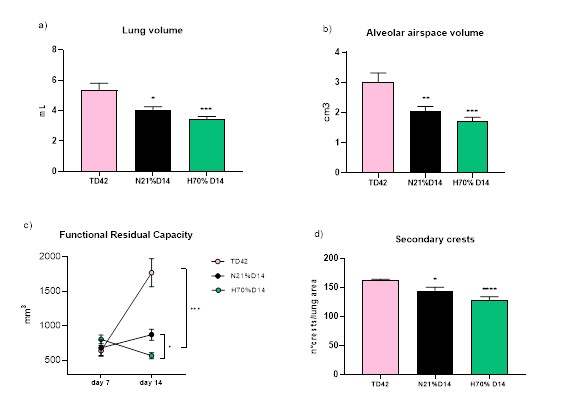Neonatal Pulmonology
Neonatal Pulmonology 6: Oxygen, Steroids
161 - Characterization of the preterm rabbit exposed to hyperoxia for 14 days as a long-term model of Bronchopulmonary Dysplasia.
Publication Number: 161.438

Chiara Catozzi (she/her/hers)
Scientist
Chiesi Farmaceutici spa
Parma, Emilia-Romagna, Italy
Presenting Author(s)
Background:
Bronchopulmonary dysplasia (BPD) is a complication of prematurity that develops during the first weeks of life and compromises lung development with long-term sequelae into adulthood. The established hyperoxia-exposed preterm rabbit model consists of delivering the pups during the saccular stage of lung development followed by a 7-day, postnatal hyperoxia exposure (95% Oxygen), combining two main etiological factors of human BPD: prematurity and hyperoxia. The present study aims to extend the model to 14 days to test drug candidates at more clinically relevant time points.
Objective:
The present study aims to extend the model to 14 days to test drug candidates at more clinically relevant time points.
Design/Methods: Preterm rabbits delivered on the 28th day of gestation were exposed to two conditions for 14 days: normoxia (21% of O2) or hyperoxia (70% O2). At postnatal days 1, 7 and 14, lung ultrasound scores (LUS) and pulmonary aeration degrees (by micro-CT scanning) were evaluated non-invasively. In addition, pulmonary function (i.e., inspiratory capacity, compliance, elastance and resistance), histological outcomes (by an artificial intelligence-based software), and stereological analysis (i.e lung volume and alveolar airspace volume) were assessed at the end of the experiment (14 days). Age-matched rabbits, born at term and left with their mothers, were used as physiological controls.
Results:
Normoxia and hyperoxia exposure up to 14 days was feasible with good survival rates (65% and 80%, respectively). Premature birth itself was associated with an impairment of lung development, as shown by the comparison of lung function, histological outcomes, micro-CT analysis, stereological analysis, and LUS scores of preterm and term rabbit pups. The continuous exposure to postnatal hyperoxia for 14 days led to further impairment in lung development compared to the normoxia group (Fig 1).
Conclusion(s): Premature birth alone, even in the absence of postnatal hyperoxia, appears to trigger a mild/moderate BPD phenotype compared to the term birth, which can be further enhanced by the postnatal exposure to 70% 02 for at least up to 14 days. Therefore, preterm rabbits, with or without hyperoxia exposure, are a useful tool for in-vivo drug screening studies. 
